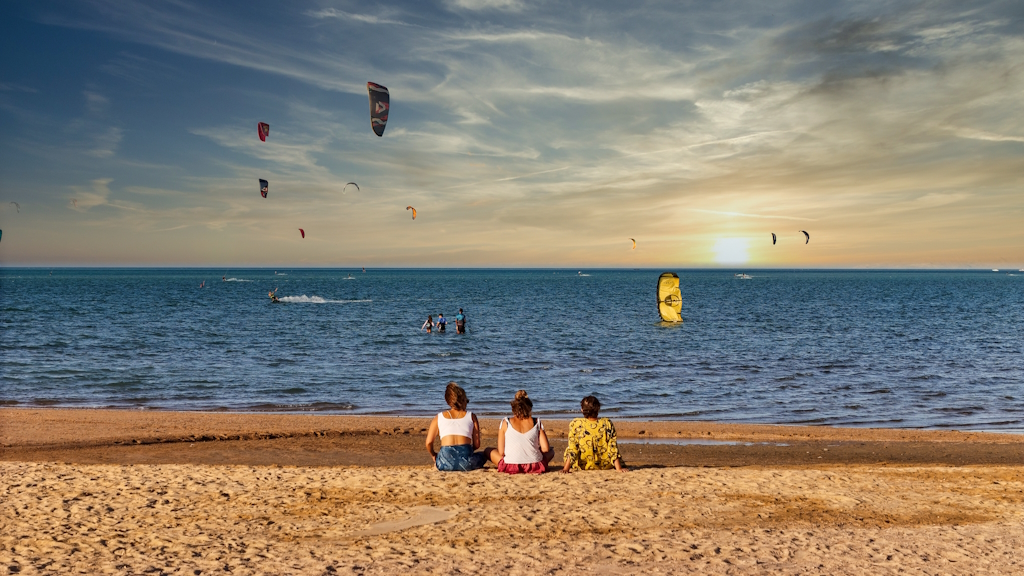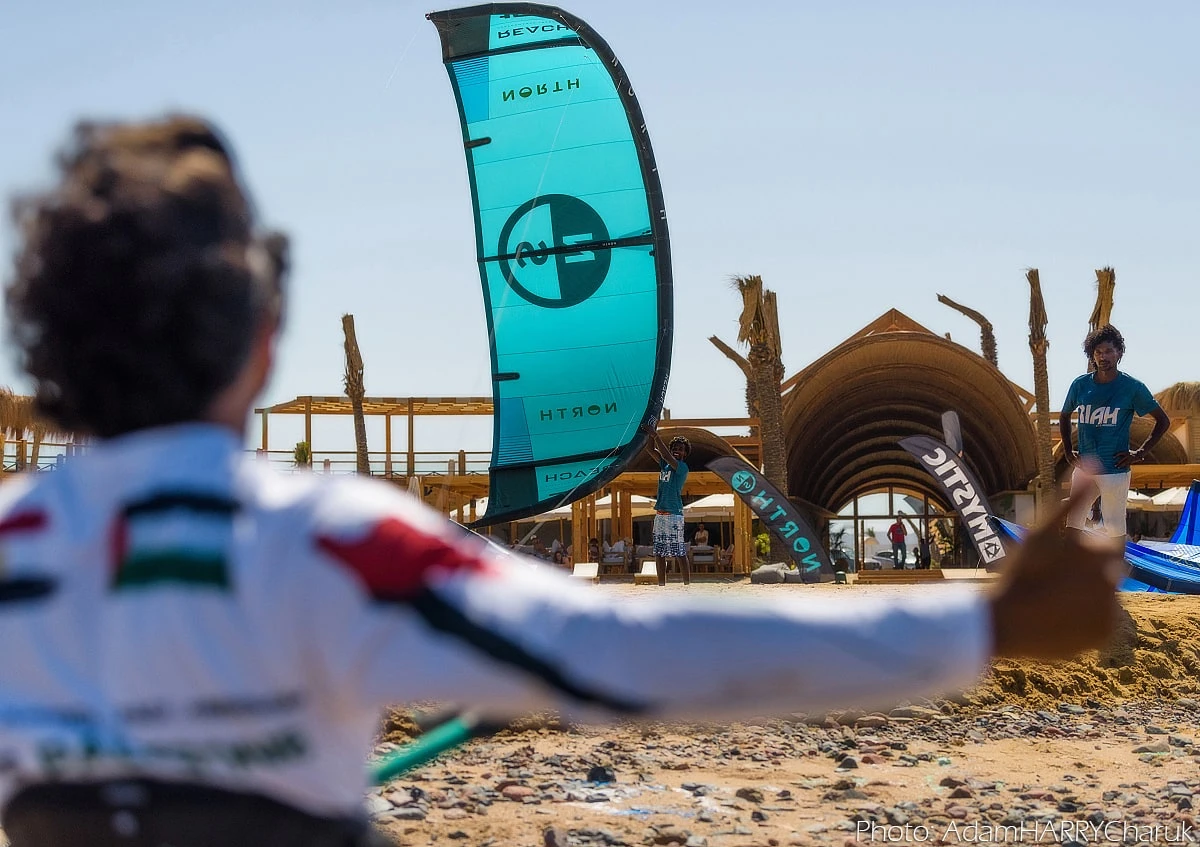Kitesurfing is an incredible sport. As a water sport powered by nothing but the wind and your own excitement it offers an unbeatable sense of freedom, joy and exhilaration. At Riah Kite Academy, our team has taught thousands of people how to kitesurf over the years, all across the world. In flat water places and wave spots, super windy locations and light wind paradises. One of the most common questions we get asked in every place and all different languages is, “Is kitesurfing dangerous?”.
The honest truth is that kitesurfing can be dangerous—but it doesn’t have to be. There is, of course, an inherent risk of injury with any high-adrenaline sport, but the vast majority of major accidents we’ve seen were entirely preventable. Minor injuries like a pulled muscle, harness chafe or some sunburn are normally the worst we see here at Riah.
So, how do you stay safe while kitesurfing or learning to kitesurf? Today, we’ll explore the three key risk areas that lead to major injuries and accidents in kitesurfing, and how you can reduce the chances of them affecting you to nearly zero!
Kitesurfing is all about harnessing the power of the wind with an inflatable kite (or foil kite, but that’s a different topic!). Naturally, that means we’re at mother nature’s mercy and discretion when we want to go out and get stoked—but nature doesn’t always follow a predictable path.
Sudden gusts or unexpected shifts in wind direction can quickly turn a leisurely session into a challenging ordeal, even catching seasoned riders off-guard. Imagine launching your kite into what seems like a steady breeze, only to find yourself wrestling against rapidly increasing gusts that tug unpredictably on your control bar. Such unexpected conditions can make kite control difficult, placing both your safety and enjoyment at risk.
Did you know that the power of the wind increases exponentially, not in a linear fashion? If the wind is 10 knots, and doubles to 20 knots, the power of the wind has actually quadrupled to four times the power! This is why finding consistent wind, and staying out of extremely gusty conditions is so important to staying safe.

The good news is that understanding whether and the likelihood of such wind events occurring is actually very easy. We don’t have time today to go deep in meteorological science and talk about how wind occurs and what impacts it, so it’s a good thing we don’t need to. The safest thing to do when you’re kitesurfing at a new location—even if you’re experienced—is to spend a little bit of time on the internet researching the local wind, or speaking to experienced locals. You’ll quickly learn if the spot is “gusty”, and whether the wind is steady, thermal wind or occurs through a more rare weather phenomenon.
But even safer than that, is to simply kitesurf at locations with well-understood, smooth and consistent wind. Like here at Riah, in El Gouna. Our wind is predominantly caused by the land heating up, and the warm air over it rising into the atmosphere. This causes a low pressure area, and the cool air over the ocean rushes in to fill it. This is one of the most common, and most favourable types of winds to kitesurf, as they’re generally moderate strength and very consistent.
Bonus Tip: Looking to book a trip to El Gouna, but don’t know where to stay or how to get there? Check out our page that has everything you need to know about travelling to and accommodation in beautiful El Gouna, Egypt.
Understanding weather patterns doesn’t have to feel like deciphering a foreign language. As well as choosing a good spot, by learning how to read forecasts, interpret local wind conditions, and recognise signs of impending weather changes, you’ll transform uncertainty into informed decision-making. At Riah Kite Academy, we offer world class kite lessons where our expert instructors don’t just show you how to ride—they teach you to predict and respond intelligently to varying conditions. Armed with these insights, you’ll step onto the sand in El Gouna with confidence, ready to conquer the wind and water safely, session after session.
Your technique on the water isn’t just about looking good—it’s your lifeline to a safe and enjoyable session. Poor kite handling or incorrect body positioning could see you struggling for control, risking unnecessary accidents or injury. Imagine losing balance due to improper weight distribution, or inadvertently sending your kite into an uncontrolled loop because of incorrect bar handling—mistakes that quickly escalate into uncomfortable or even hazardous situations. It might seem like a vast ocean out there, but when you’re out of control, it’s surprisingly easy to find yourself tangled with another rider.
However, these dangers are easily avoidable when you master the fundamentals from the outset. With expert-led training, such as that provided by our dedicated and highly qualified instructors at Riah, you’ll be guided through every essential element—from correct kite setup and launching to maintaining balance and executing precise turns. Through carefully designed, personalised instruction sessions, we ensure each student is thoroughly prepared for real-world scenarios. This robust foundation won’t just keep you safer on the water; it’ll make every part of your kitesurfing experience better, allowing you to truly embrace the thrill and adventure that the sport has to offer.

Bonus Tip: One of the fastest ways to learn to kitesurf safely, proficiently and with the most fun is by doing a kite camp. It’s an all-inclusive, fast-track experience designed to take your from absolute beginner to total shredder in no time at all!
Reliable gear isn’t just nice to have; it’s essential. Neglected equipment—such as frayed control lines, leaky kite bladders, or faulty safety systems—can fail precisely when you need it most, potentially leading to accidents and dangerous situations. Imagine being out on the water, executing a perfect transition, only for a worn line to snap unexpectedly. Not only would this ruin your session, but it could also put you in genuine danger, leaving you stranded or struggling in open water, or stuck beneath a kite that’s looping uncontrollably.
Fortunately, these scenarios are entirely preventable through regular equipment checks and proactive maintenance. At Riah Kite Academy, we place great emphasis on teaching our students to routinely inspect their gear for signs of wear and tear, ensuring everything is in top-notch condition before they even step into the lagoon. By embedding meticulous care into your regular pre-session rituals, you’ll gain absolute trust in your equipment. This preparedness means you can channel all your focus into your progression and enjoyment, making every session in El Gouna’s perfect flat-water conditions something to look forward to, worry-free.

While kitesurfing carries certain risks, these can be effectively managed through diligent preparation, proper training, and ongoing education. By staying informed about weather conditions, honing technical skills, and maintaining equipment, every prospective kiter can embrace the thrill of kitesurfing with confidence, peace of mind and safety.
At Riah Kite Academy in El Gouna, we are committed to providing a safe learning environment, making the most of the area’s consistent winds and flat waters to offer ideal conditions for beginners. We invite you to join us and start your kitesurfing journey, secure in the knowledge that your safety and enjoyment are our absolute highest priority.
So what are you waiting for? Check out our kitesurfing lessons page today!